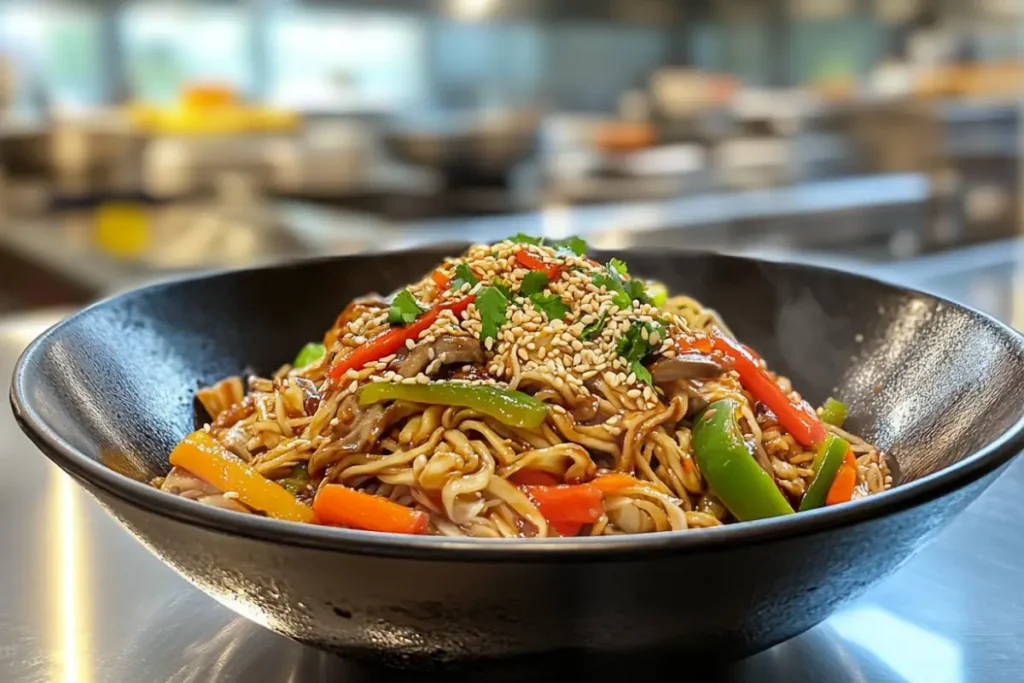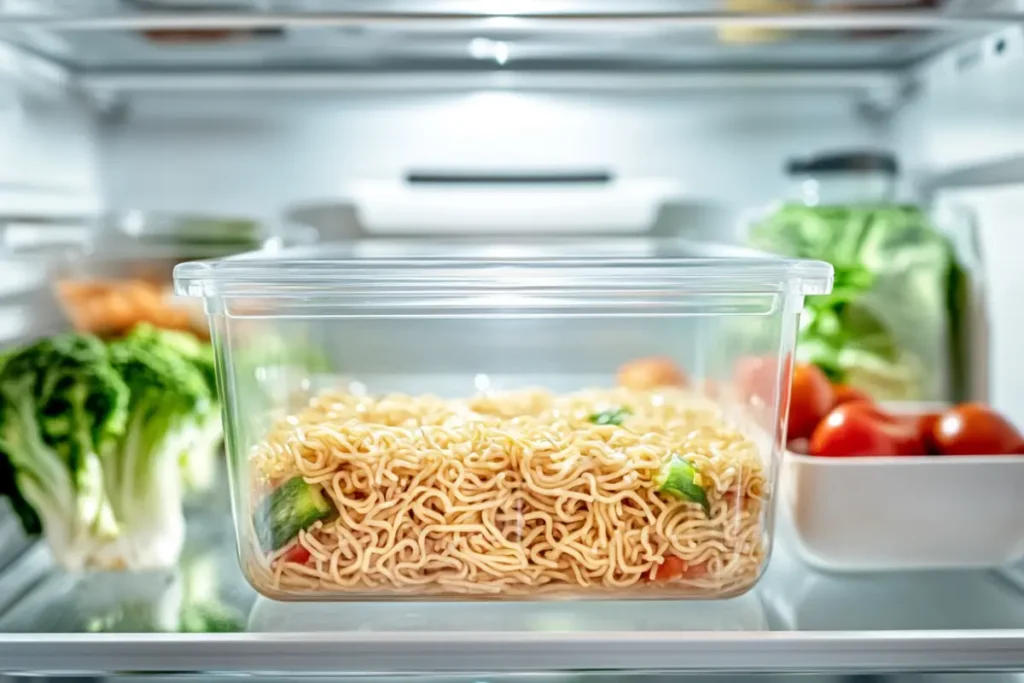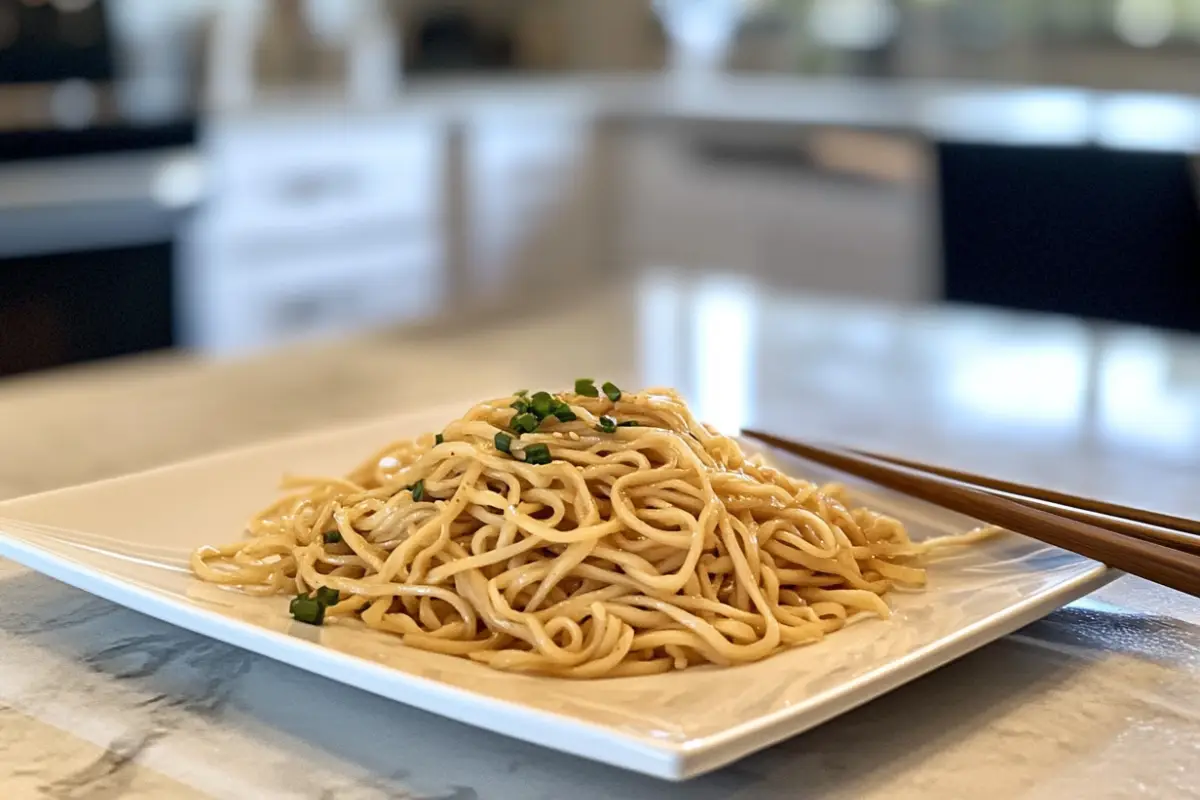Last Updated on February 12, 2025 by Souhail
Mongolian barbecue is a delightful, interactive dining experience where diners select ingredients, and a chef cooks them on a large, hot griddle. Among the key components of this dish, the noodle used for Mongolian barbecue plays a pivotal role in defining its texture, flavor, and authenticity. Whether you’re making Mongolian barbecue at home or visiting your favorite grill restaurant, understanding the right type of noodle can elevate the entire dish.
In this article, we’ll delve into the types of noodles traditionally used, explore their unique qualities, and provide practical tips for choosing or substituting noodles for Mongolian barbecue. From chewy classics to creative alternatives, let’s unravel the secrets of this essential ingredient!
Table of contents
- Why Noodles Are Essential to Mongolian Barbecue
- What Noodle Is Used for Mongolian Barbecue?
- Choosing the Perfect Noodle
- Comparing Fresh vs. Dried Noodles
- Best Noodle Types for Mongolian Barbecue
- Pairing Noodles with Sauces and Ingredients
- Common Mistakes When Cooking Noodles for Mongolian Barbecue
- Noodles and Dietary Considerations
- How to Store and Reuse Leftover Noodles
- Variants and Substitutes
- Pro Tips for Perfect Mongolian Barbecue with Noodle
- FAQs
- Final Toughts
Why Noodles Are Essential to Mongolian Barbecue
Noodles are more than just a filler in Mongolian barbecue—they’re the glue that brings the dish together. Their texture contrasts beautifully with the crisp vegetables and tender proteins, while their absorbent nature soaks up the savory, sweet, and smoky sauces that define this cuisine.
Typically, the noodle used for Mongolian barbecue must meet the following criteria:
- Firm yet Chewy Texture: To hold up against the high-heat grilling process.
- Neutral Flavor: Allowing the sauces and seasonings to shine.
- Absorbent Quality: To retain the flavors of the marinade and sauce.
What Noodle Is Used for Mongolian Barbecue?
The Classic Choice: Wheat-Based Noodles
The most traditional noodle used for Mongolian barbecue is a wheat-based noodle, such as lo mein. These noodles are thick, slightly chewy, and perfect for soaking up sauces without becoming mushy. Their neutral flavor complements the bold seasonings and grilled ingredients, making them a favorite among chefs and diners alike.
Egg Noodles for Richness and Depth
Egg noodles are another popular choice, offering a slightly richer taste due to their egg content. These noodles are often used in Mongolian barbecue for their firm texture, which holds up well under the intense heat of the griddle. They also provide a subtle buttery undertone that enhances the overall flavor of the dish.
Rice Noodles: A Gluten-Free Option
For those seeking a gluten-free alternative, rice noodles are a fantastic substitute. Thin varieties, like vermicelli, are light and crisp, while thicker rice noodles offer a satisfying chew. Although they don’t absorb sauces as well as wheat noodles, their delicate texture creates a unique balance in the dish.
Udon Noodles: A Heartier Alternative
Originating from Japan, udon noodles are thick, chewy, and satisfyingly hearty. While not traditional to Mongolian barbecue, they’ve gained popularity for their ability to stand up to rich, bold flavors. These noodles are an excellent option if you’re looking for something with a more substantial bite.
Glass Noodles: Light and Translucent
Also known as cellophane or bean thread noodles, glass noodles are made from starches like mung bean or potato. They’re a less common choice for Mongolian barbecue but provide a unique, slippery texture and a light base for those who prefer a subtler noodle presence.
Choosing the Perfect Noodle
When selecting a noodle used for Mongolian barbecue, consider these factors:
- Cooking Method: Noodles need to withstand high heat without breaking apart.
- Dietary Needs: Gluten-free? Vegan? Choose noodles that cater to your preferences.
- Flavor Profile: Match the noodle’s flavor intensity with the sauce and ingredients.
- Accessibility: Stick to noodles readily available at your local store or online.
Comparing Fresh vs. Dried Noodles
When it comes to the noodle used for Mongolian barbecue, one of the first choices you’ll face is between fresh and dried varieties. Each has its own merits, and the decision often depends on your cooking style, availability, and personal preference.
Fresh Noodles
- Advantages: Fresh noodles are softer and have a more authentic, handmade texture. They cook quickly and absorb sauces beautifully, resulting in a restaurant-quality dish.
- Drawbacks: They’re perishable and require refrigeration, which means a shorter shelf life. Fresh noodles are also slightly more expensive and harder to find in stores.
- Best For: If you want an authentic experience and have access to fresh noodles, these are ideal. Look for them in Asian grocery stores or specialty food markets.
Dried Noodles
- Advantages: Dried noodles are long-lasting, affordable, and widely available. They’re perfect for pantry stocking and offer more convenience for home cooks.
- Drawbacks: They require boiling and careful cooking to avoid overcooking. Dried noodles may not be as tender or chewy as their fresh counterparts.
- Best For: Casual home cooks or those with limited access to fresh noodles. They’re also a great choice for experimenting with various noodle types.
Ultimately, both options work well for Mongolian barbecue, but fresh noodles shine in terms of flavor and texture, while dried noodles excel in convenience.
Best Noodle Types for Mongolian Barbecue
Choosing the right noodle brand can make all the difference when crafting your Mongolian barbecue. Here are some top recommendations based on noodle type:
- Lo Mein (Wheat-Based Noodles)
- Twin Marquis Fresh Lo Mein Noodles: These fresh noodles are restaurant-quality and ideal for stir-fries and Mongolian barbecue.
- Wel Pac Lo Mein Noodles: A dried alternative with great texture and easy preparation.
- Egg Noodles
- Blue Dragon Medium Egg Noodles: Easy to cook and rich in flavor, perfect for capturing sauces.
- Golden Dragon Egg Noodles: Widely available and loved for their firm texture.
- Rice Noodles
- Three Ladies Brand Rice Vermicelli: A top choice for gluten-free Mongolian barbecue enthusiasts.
- Thai Kitchen Thin Rice Noodles: Versatile and readily available in most grocery stores.
- Udon Noodles
- Hakubaku Organic Udon: These thick noodles are hearty and satisfying.
- Ka-Me Udon Stir-Fry Noodles: Pre-cooked and ready to toss into your Mongolian barbecue.
- Glass Noodles
- Dynasty Cellophane Noodles: A reliable option for a slippery, light texture.
- Longkou Bean Thread Noodles: Widely used in Asian cooking and great for Mongolian barbecue.
Pairing Noodles with Sauces and Ingredients

The noodle used for Mongolian barbecue can transform depending on the sauces and ingredients paired with it. Here’s how to create harmonious flavor combinations:
- Lo Mein Noodles: Pair with bold, savory sauces like garlic soy or hoisin. Add tender proteins like beef or chicken and crunchy vegetables like bell peppers or onions.
- Egg Noodles: These work well with rich, umami sauces such as oyster sauce or sesame oil. Combine them with shrimp or pork and leafy greens for balance.
- Rice Noodles: Best with lighter sauces, such as a spicy chili-lime mix. Complement with seafood or tofu for a gluten-free option.
- Udon Noodles: Pair with thick, robust sauces like peanut or teriyaki. Add mushrooms, bok choy, and grilled beef for a hearty dish.
- Glass Noodles: Match with light, sweet sauces like honey-ginger glaze. Add shredded chicken or crispy vegetables for a delicate, textured meal.
Common Mistakes When Cooking Noodles for Mongolian Barbecue
Even the best noodle used for Mongolian barbecue can fall short if not cooked properly. Avoid these common pitfalls:
- Overcooking the Noodles
- Problem: Overcooked noodles turn mushy and fall apart on the griddle.
- Solution: Cook noodles just shy of al dente and rinse with cold water to halt the cooking process.
- Skipping the Oil Toss
- Problem: Noodles stick together, making them clump on the griddle.
- Solution: Toss cooked noodles with sesame or vegetable oil to keep them separate.
- Using Undercooked Noodles
- Problem: Hard, undercooked noodles won’t absorb flavors properly.
- Solution: Ensure noodles are fully cooked before adding them to the grill.
- Adding Noodles Too Early
- Problem: Noodles burn or dry out during cooking.
- Solution: Add noodles near the end of grilling to retain their texture and absorb flavors.
- Not Pre-Seasoning Noodles
- Problem: Plain noodles can taste bland.
- Solution: Toss noodles in a light sauce or seasoning before cooking for extra flavor.
Noodles and Dietary Considerations
The noodle used for Mongolian barbecue can easily be adapted to fit various dietary needs. Here are some options:
- Gluten-Free Diets
- Use rice noodles or glass noodles, which are naturally gluten-free. Always check labels to ensure no added wheat starch.
- Vegan Diets
- Stick to rice, glass, or wheat noodles without egg content. Avoid egg noodles for a vegan-friendly option.
- Low-Carb Diets
- Zucchini noodles (zoodles) or shirataki noodles are great low-carb substitutes. They work well with lighter, low-sugar sauces.
- High-Protein Diets
- Pair high-protein noodles, like chickpea or lentil-based varieties, with Mongolian barbecue for an extra nutrient boost.
- Low-Sodium Needs
- Choose plain noodles without added salt and control the sodium in your sauces and seasonings.
How to Store and Reuse Leftover Noodles

Proper storage is essential to maintaining the texture and flavor of leftover noodles. Here’s how to do it:
- Storage Tips
- Cool noodles completely before storing to prevent condensation.
- Place them in an airtight container or resealable bag to retain moisture.
- Store in the refrigerator for up to 3 days.
- Reheating Noodles
- Use a microwave: Add a splash of water or sauce to the noodles, cover, and heat in 30-second intervals.
- Stir-fry: Toss noodles in a hot pan with oil and a bit of sauce for a quick refresh.
- Steam: Place noodles in a heatproof dish over boiling water and cover to steam gently.
- Repurposing Leftover Noodles
- Noodle Stir-Fry: Toss with vegetables, protein, and sauce for a new meal.
- Noodle Soup: Add to a broth with herbs and toppings for a comforting dish.
- Cold Noodle Salad: Combine with sesame dressing, cucumbers, and carrots for a refreshing twist.
By following these steps, you can ensure your leftover noodles remain just as delicious the next day.
Variants and Substitutes
If you can’t find the traditional noodles for Mongolian barbecue, here are some great substitutes:
- Spaghetti or Linguine: Cooked al dente, these pasta varieties mimic lo mein’s texture.
- Soba Noodles: Made from buckwheat, soba offers a nutty, earthy flavor.
- Zucchini Noodles (Zoodles): A low-carb, vegetable-based alternative for health-conscious diners.
- Shirataki Noodles: A zero-calorie option made from konjac yam.
Pro Tips for Perfect Mongolian Barbecue with Noodle
- Don’t Overcook: Slightly undercook the noodles to prevent them from becoming mushy on the griddle.
- Toss in Oil: Coat noodles lightly with sesame or vegetable oil to keep them from sticking.
- Pair with Sauce: Use bold, savory sauces like hoisin, soy, or garlic for maximum flavor absorption.
- Prep Ingredients: Pre-cook noodles before adding them to the griddle to ensure even cooking.
FAQs
Udon noodles aren’t traditional, but they are a hearty and delicious alternative. Their thick, chewy texture pairs well with bold sauces and grilled ingredients.
To prevent noodles from sticking, rinse them under cold water after boiling, then toss with a small amount of sesame or vegetable oil. This creates a non-stick coating and makes them easier to handle on the griddle.
Absolutely! Rice noodles and glass noodles are excellent gluten-free alternatives. Be sure to check the packaging for gluten-free certifications if needed.
Leftover noodles can be transformed into a variety of dishes, such as stir-fried noodles, noodle soups, or cold noodle salads. Properly store them in an airtight container in the refrigerator for up to three days.
Final Toughts
Selecting the right noodle used for Mongolian barbecue is key to crafting a delicious and satisfying dish. Whether you choose classic lo mein, egg noodles for extra richness, or gluten-free rice noodles, the right noodle will perfectly complement the bold flavors and textures of Mongolian barbecue.
As we’ve explored, the type of noodle you choose can truly elevate the dish, not only offering a foundation that effectively absorbs sauces but also pairing beautifully with proteins and vegetables. Furthermore, it’s important to avoid common cooking mistakes to ensure the best results. Additionally, don’t hesitate to experiment with substitutes like udon or even spaghetti, as these can provide a creative and exciting twist to your Mongolian barbecue.
If you’re feeling inspired to create a full Mongolian grill experience, be sure to check out our recipe post on Mongolian Grill. It’s packed with detailed instructions, sauce ideas, and ingredient combinations to help you recreate this iconic dish at home.
With proper preparation, careful storage, and thoughtful pairing, your noodles can undoubtedly become the star of your Mongolian barbecue experience. Moreover, with the right techniques and ingredients, you’ll be able to craft a dish that’s both delicious and memorable. So, now it’s time to gather your ingredients, heat up the griddle, and fully enjoy the magic of creating this flavorful dish.
In addition, feel free to share your results, helpful tips, or even any noodle discoveries you’ve made in the comments—we’d absolutely love to hear from you! Furthermore, if you’re craving even more culinary inspiration, don’t forget to explore our related articles on sauces and barbecue essentials for more exciting ideas.

